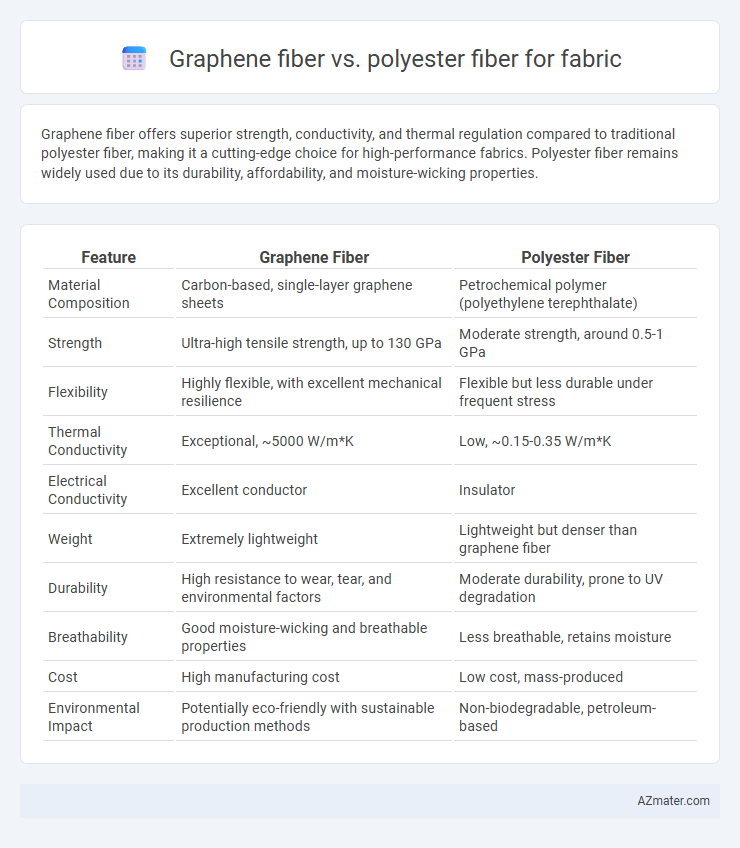Graphene fiber offers superior strength, conductivity, and thermal regulation compared to traditional polyester fiber, making it a cutting-edge choice for high-performance fabrics. Polyester fiber remains widely used due to its durability, affordability, and moisture-wicking properties.
Table of Comparison
| Feature | Graphene Fiber | Polyester Fiber |
|---|---|---|
| Material Composition | Carbon-based, single-layer graphene sheets | Petrochemical polymer (polyethylene terephthalate) |
| Strength | Ultra-high tensile strength, up to 130 GPa | Moderate strength, around 0.5-1 GPa |
| Flexibility | Highly flexible, with excellent mechanical resilience | Flexible but less durable under frequent stress |
| Thermal Conductivity | Exceptional, ~5000 W/m*K | Low, ~0.15-0.35 W/m*K |
| Electrical Conductivity | Excellent conductor | Insulator |
| Weight | Extremely lightweight | Lightweight but denser than graphene fiber |
| Durability | High resistance to wear, tear, and environmental factors | Moderate durability, prone to UV degradation |
| Breathability | Good moisture-wicking and breathable properties | Less breathable, retains moisture |
| Cost | High manufacturing cost | Low cost, mass-produced |
| Environmental Impact | Potentially eco-friendly with sustainable production methods | Non-biodegradable, petroleum-based |
Introduction to Graphene Fiber and Polyester Fiber
Graphene fiber, known for its exceptional strength, electrical conductivity, and lightweight properties, outperforms traditional fibers in advanced textile applications, offering enhanced durability and flexibility. Polyester fiber, a synthetic polymer made from polyethylene terephthalate (PET), is widely used for its affordability, moisture resistance, and ease of care in everyday fabrics. Comparing these materials highlights graphene fiber's innovation-driven performance against polyester fiber's cost-effective versatility in textile manufacturing.
Chemical Composition and Structure Comparison
Graphene fiber consists of a single layer of carbon atoms arranged in a two-dimensional honeycomb lattice, providing exceptional electrical conductivity, mechanical strength, and flexibility. Polyester fiber, a synthetic polymer made from polyethylene terephthalate (PET), features long-chain hydrocarbons with ester functional groups, offering durability, hydrophobicity, and resistance to stretching and shrinking. The atomic structure of graphene fiber enables superior tensile strength and thermal conductivity compared to the semicrystalline, polymeric structure of polyester, which emphasizes elasticity and chemical stability for fabric applications.
Mechanical Strength: Durability and Flexibility
Graphene fiber exhibits superior mechanical strength compared to polyester fiber, offering enhanced tensile strength and exceptional durability under stress. Its flexibility allows fabrics to withstand repeated deformation without losing structural integrity, outperforming polyester's tendency to degrade and stretch over time. The integration of graphene fiber in textiles significantly extends fabric lifespan while maintaining lightweight and resilient properties.
Breathability and Moisture Management
Graphene fiber outperforms polyester fiber in breathability by allowing superior air circulation and rapid moisture vapor transmission, which helps maintain a dry and comfortable fabric environment. Its moisture management capabilities include efficient sweat absorption and quick drying due to the high thermal conductivity of graphene, reducing the buildup of humidity and odor. In contrast, polyester fiber tends to trap moisture and restrict airflow, leading to less effective breathability and prolonged dampness on the skin.
Thermal Conductivity and Insulation Properties
Graphene fiber exhibits exceptional thermal conductivity, surpassing polyester fiber by efficiently dissipating heat and maintaining temperature regulation in fabrics. Polyester fiber, with lower thermal conductivity, provides superior insulation by trapping heat and reducing heat transfer, making it ideal for retaining warmth. Combining graphene's heat dispersion with polyester's insulating qualities can optimize fabric performance for advanced thermal management applications.
Weight and Comfort in Daily Wear
Graphene fiber offers exceptional lightweight properties, significantly reducing fabric weight compared to traditional polyester fiber, enhancing comfort in daily wear. Its superior breathability and thermal regulation support moisture-wicking and temperature control, making it ideal for extended use. Polyester fiber, while durable and cost-effective, tends to be heavier and less breathable, which can impact long-term comfort in everyday clothing.
Environmental Impact and Sustainability
Graphene fiber offers significant environmental advantages over polyester fiber due to its renewable sourcing, biodegradability, and lower carbon footprint during production. Polyester fibers, derived from petroleum, contribute to microplastic pollution and are non-biodegradable, leading to long-term environmental persistence in landfills and oceans. Sustainable fabric innovation increasingly prioritizes graphene fiber for its eco-friendly lifecycle and reduced environmental impact compared to traditional synthetic fibers.
Cost and Manufacturing Considerations
Graphene fiber offers superior strength and conductivity but remains significantly more expensive than polyester fiber due to complex production processes involving chemical vapor deposition or exfoliation methods. Polyester fiber benefits from well-established, cost-efficient manufacturing techniques like melt spinning, enabling mass production at lower prices. Choosing between the two fibers depends on balancing graphene's high-performance advantages against polyester's affordability and scalability in fabric manufacturing.
Applications in the Textile Industry
Graphene fiber offers superior strength, conductivity, and thermal regulation compared to traditional polyester fiber, making it ideal for advanced textile applications such as smart clothing, wearable electronics, and high-performance sportswear. Polyester fiber remains widely used due to its cost-effectiveness, durability, and moisture-wicking properties, supporting mass production in everyday apparel and industrial fabrics. The textile industry increasingly integrates graphene fibers to enhance functionality and sustainability while maintaining polyester's accessibility for standard fabric manufacturing.
Future Prospects and Innovations in Fabric Technology
Graphene fiber offers superior strength, conductivity, and flexibility compared to traditional polyester fiber, positioning it as a transformative material in fabric technology. Innovations in graphene composites aim to enhance thermal regulation, durability, and smart textile applications, driving future developments in wearable tech and performance apparel. Research into scalable production methods is crucial to wider adoption, potentially revolutionizing sustainable and high-performance fabrics over the next decade.

Infographic: Graphene fiber vs Polyester fiber for Fabric
 azmater.com
azmater.com